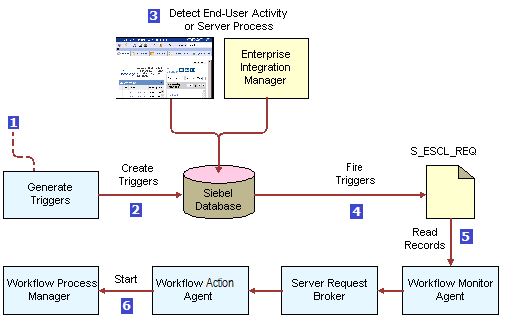Sequence That a Workflow Policy Uses
The following figure illustrates the sequence of steps that a typical Workflow Policy follows.

As shown in this figure, the sequence for a typical Workflow Policy is as follows:
-
Define Workflow Policies. Administrator defines Workflow Policies to be monitored.
-
Create Triggers. To enforce Workflow Policies, Siebel CRM uses database triggers at the data layer. If the conditions for a Workflow Policy are met, then these database triggers capture the database event and provide this information to the Workflow Policy Manager server component.
-
Detect End-User Activity or Server Process. An end-user activity or server process occurs.
-
Fire Triggers. Fire triggers populating the S_ESCL_REQ table with information about the policy being violated.
-
Read Records. The Workflow Monitor Agent reads records in the S_ESCL_REQ table. To process requests, it then runs the actions that are defined for the Workflow Policy. The Workflow Monitor Agent is a component of the Workflow Policy Manager.
-
Start Workflow Actions. Start the Workflow Actions that have been defined, such as, invoking a Workflow Process, sending a text message, or sending an email.
For more information about:
-
Workflow Action Agent, see Running a Workflow Policy with the Workflow Action Agent.
-
Generate Triggers, Workflow Process Manager and Workflow Monitor Agent, see Siebel Workflow Process Runtime Architecture.
-
The S_ESCL_REQ table, see Fixing Problems in the S_ESCL_REQ Table.